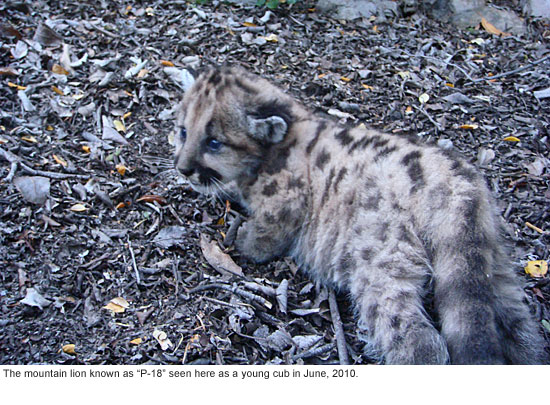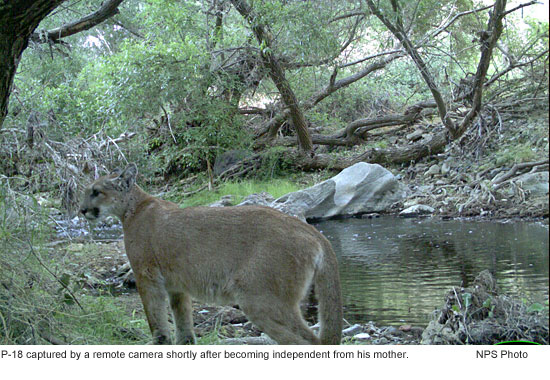 He was little more than a teenager, strong and healthy, big for his age and not yet fully grown. What he was doing at night near the freeway is uncertain; those who knew him believe that like, most late adolescents, he was just looking for some turf that hadn’t already been claimed by others, just trying to strike out on his own.
He was little more than a teenager, strong and healthy, big for his age and not yet fully grown. What he was doing at night near the freeway is uncertain; those who knew him believe that like, most late adolescents, he was just looking for some turf that hadn’t already been claimed by others, just trying to strike out on his own.
In any case, the 15-month-old mountain lion known to the National Park Service as P-18 (the “P” stood for “Puma”) somehow wandered onto the 405 Freeway just south of the Getty Center southbound onramp shortly after 4 a.m. Tuesday. His death was a hit-and-run.
“He was found at 7:30 am when traffic started backing up and the CHP went in and found a dead lion with a GPS collar,” says a stricken Christie Brigham, chief of planning, science and resource management for the Santa Monica National Recreation Area. Born last May in the Santa Monica Mountains and part of a decade-long national study, the lion’s movements had been tracked since he was three weeks old.
A total of 21 mountain lions have been tracked since 2002 in the area, says Woody Smeck, park superintendent in the Santa Monica Mountains National Recreation Area. Of those, Smeck says, only one is known to have successfully crossed a freeway. A lion known as P-12 crossed Highway 101 in 2009 into the Santa Monica Mountains near Liberty Canyon. He survived to father the cub who died this week.
Southern California’s freeways may not invite their denizens to think much about nature, but wildlife crossings are a significant transportation issue in L.A. Great swaths of natural habitat here are bisected by asphalt, which may impede the movement of coyotes, mountain lions, bobcats, raccoons and other native species but doesn’t stop their instinct to travel in search of food and mates.
Wild animals require safe access to new territory so they don’t inbreed and endanger their species’ survival. Male mountain lions in particular tend to range widely, says Brigham, and previous tracking has shown them to range throughout the entirety of the Santa Monica Mountains, from Camarillo to the 405 Freeway.
P-18, she says, was one of four lions being tracked this summer; he had appeared to be slowly making his way east from his mother’s home range in Malibu Creek State Park. Radio telemetry signals from his collar placed him near the Getty Center around 4 a.m. just south of an onramp
“We suspect there was another, untagged, male lion using that part of the moutain, which meant it wasn’t an open territory for him as a young male,” says Brigham. “We think he was trying to disperse out of the Santa Monicas in search of open space when he was hit.”
Brigham says the area where P-18 died has been especially lethal to wildlife. “We found an un-collared, road-killed lion in the same area in 2008, “ she says.
Moreover, she says, P-18’s life might have been spared had he padded a mile or so further north to the Sepulveda Boulevard undercrossing. Motion-sensitive cameras, which have been set up there to track wildlife, have shown that, while it is not the ideal wildlife crossing—it was built for 4-wheeled vehicles, not 4-legged creatures—and rarely used by mountain lions, it is heavily used by other wildlife with relative safety.
Unbroken fencing might have funneled the lion to a safe passage, says Brigham. “But there was nothing to direct him to that area.”
Wildlife issues have been under discussion with Caltrans and other agencies as part of the 405 freeway widening project, says Brigham, but money has been tight and fencing proposals have run up against right-of-way and setback issues.
“There are rules about how far the fence has to be from the roadway,” she points out, “and not all of the land involved is Caltrans right-of-way.”
Plans for improved lighting and wildlife access are in the works in a few spots including the Skirball Center Drive bridge area and the Bel Air Crest Road undercrossing, “but the ultimate solution is to put in wildlife crossings that will be effective and funnel animals to the appropriate place.”
The 405 isn’t the only freeway with a wildlife problem; Highways 101 and 118 also bisect important habitat. Nor is the issue just one of road-kill—a wild animal trapped on a freeway is lethal to motorists, too.
Caltrans has applied for a $10 million federal grant to build a wildlife tunnel in Agoura Hills under the 101 at Liberty Canyon Road, says Francis Appiah, an associate environmental planner and natural scientist at the state agency. But the grant has yet to be approved.
“Investing in connected pieces of parkland and constructing wildlife crossings along major freeways around Los Angeles is essential for long term mountain lion survival in the Santa Monica Mountains,” says park superintendent Smeck.







